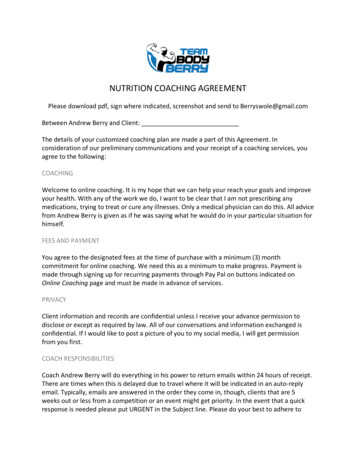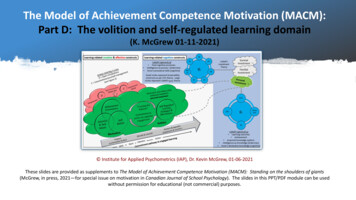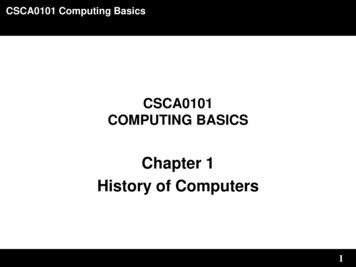
Transcription
3Berry phases and curvaturesA “Berry phase” is a phase angle (i.e., running between 0 and 2π) that describes the global phase evolution of a complex vector as it is carried arounda path in its vector space. It can also be referred to as a “geometric phase”or a “Pancharatnam phase,” the latter after early work by Pancharatnam(1956). The concept was systematized and popularized in the 1980s by SirMichael Berry, notably in a seminal paper (Berry, 1984), and by Berry andothers in a series of subsequent publications that are well represented inthe edited volume of Wilczek and Shapere (1989). A formal discussion ofBerry phases and related concepts (fiber bundles, connections, Berry curvatures, etc.) can be found in modern texts on topological physics such asthose by Frankel (1997), Nakahara (2003), and Eschrig (2011). Since then,Berry phases have found broad application in diverse realms of science including atomic and molecular physics, classical optics, wave mechanics, andcondensed-matter physics.Our goal here is to introduce the concept of the Berry phase and explain how it enters into the quantum-mechanical band theory of electronsin crystals. We will begin by introducing the Berry phase in its abstractmathematical form, and then discuss its application to the adiabatic dynamics of finite quantum systems. After these preliminaries, we will turnto the main theme of this book, where the complex vector in question is aBloch wavevector, and the path lies in the space of wavevectors k within theBrillouin zone.3.1 Berry phase, gauge freedom, and parallel transportAs indicated above, a Berry phase is a quantity that describes how a globalphase accumulates as some complex vector is carried around a closed loop ina complex vector space. Since we are only interested in phases, we can take
3.1 Berry phase, gauge freedom, and parallel transport u3〉63 u2〉 u1〉 uN〉 u0〉 uN-1〉Figure 3.1 Illustration of the evolution of some complex unit vector u⟩around a path in parameter space. The first and last points u0 ⟩ and uN ⟩are identical.these complex vectors to be unit vectors, and we will typically identify themwith the ground-state wavefunction of some quantum system. For example,the vector could represent the ground state of the electrons in a moleculewith fixed nuclear coordinates, or that of a spinor in an external magneticfield. We then consider a gradual variation that returns the system to itsstarting point at the end of the loop. The situation is sketched in Fig. 3.1,where states u0 ⟩, ., u7 ⟩ correspond to the N 8 points around the loop(with u8 ⟩ u0 ⟩).For a concrete example, consider the triatomic molecule shown in Fig. 3.2.It is almost equilateral, but a distortion has been introduced so as to shortenone of the three bonds slightly, as indicated by the “double bond” in thefigure. We have in mind a continuous deformation path, with each of thethree bonds being gradually shortened and lengthened in such a way thatthe illustrations in Fig. 3.2 represent snapshots along the way.1 We thenwish to consider the phase evolution of the ground state of this molecule asit is carried around the loop. Or, consider the evolution of the ground stateof a spinor (e.g., an electron or proton) in an external magnetic field as thedirection of this field varies around some closed loop on the unit sphere. Ineach case, the Berry phase will encode some information about the phaseevolution of the ground state along the path in question.3.1.1 Discrete formulationLet’s start with a discrete formulation, in which N representative vectors u0 ⟩ to uN 1 ⟩ are chosen around this loop, as for example with N 3 inFig. 3.2. Note that uN ⟩ and u0 ⟩ are identical. The Berry phase φ is then1Note that the molecule itself is not rotating; only the pattern of shortened bonds is rotating.This is often referred to as a “pseudorotation” and plays an important role in the physics ofJahn-Teller effects in molecules.
64Berry phases and curvatures(a)(b)(c)(d)Figure 3.2 Triangular molecule going though a sequence of distortions inwhich first the bottom, then the upper-right, then the upper-left bond isthe shortest and strongest of the three. The configurations in panels (a)and (d), representing the beginning and end of the loop, are identical.defined to beφ Im ln [⟨u0 u1 ⟩⟨u1 u2 ⟩.⟨uN 1 u0 ⟩] .(3.1)Recall that for a complex number z z eiϕ , the expression Im ln z ϕ justtakes the complex phase and discards the magnitude. Thus, the Berry phaseφ is minus the complex phase of the product of inner products of the statevectors at neighboring points around the loop. (Note that the sign conventionis not universal, and some authors define the Berry phase without the minussign in Eq. (3.1).)Let’s first consider a simple example based on the triatomic moleculeof Fig. 3.2. Suppose that there are two degenerate states 1⟩ and 2⟩ forthe equilateral triangle, but that the distortion causes a breaking of thisdegeneracy at all points along the loop. Following the lower-energy of thetwo states, we might find that these are ua ⟩ ud ⟩ 121( ),1 ub ⟩ 12(1),e2πi/3 uc ⟩ 121( 4πi/3 ) .e(3.2)corresponding to the distorted states in Fig. 3.2, where the top and bottomelements in the column vector are the amplitudes on basis states 1⟩ and 2⟩respectively. A trivial computation then shows that the corresponding Berryphase isφ Im ln [⟨ua ub ⟩⟨ub uc ⟩⟨uc ua ⟩] Im ln [(eπi/3 3) ] π2(3.3)(or equivalently φ π, since a phase is only well-defined modulo 2π.) Incidentally, you can see that the setting in a complex vector space is important;in the case of real vectors, the global product in Eq. (3.1) is always real, sothe Berry phase is always 0 or π depending on the sign of that product.2It is probably not yet obvious why the Berry phase defined in this way is2For the states in Eq. (3.2) it happens that φ π, but this is an artifact of the special form ofthose states.
3.1 Berry phase, gauge freedom, and parallel transport65a useful quantity, but at least it is mathematically well-defined in the sensethat it is independent of the choices made for the phases of the individual uj ⟩. That is, suppose we introduce a new set of N states ũj ⟩ e iβj uj ⟩(3.4)(βj is real) related to the old ones by a j-dependent phase rotation βj , anoperation that is known as a “gauge transformation” in the Berry-phasecontext.3 Then the Berry phase φ is unaffected, since any given vector, suchas u2 ⟩, appears in Eq. (3.1) once in a ket and once in a bra, so that thephases e iβj cancel out. For example, we can replace uc ⟩ in Eq. (3.2) by thephysically equivalent vector uc ⟩ e2πi/3 1 ()21(3.5)and confirm that the final result of the computation in Eq. (3.3) is thesame. The gauge-invariance of the Berry phase strongly hints that it maybe connected with some physically observable phenomena.We have passed over a subtlety above, namely the need to impose a branchchoice on the definition of Im ln z, as by restricting it to the interval π φ π. In this case, Eq. (3.1) always results in a Berry phase lying in thisinterval, while the nominally equivalent expressionN 1φ Im ln ⟨uj uj 1 ⟩(3.6)j 0can yield a result that differs by an integer multiple of 2π. If we take theviewpoint that φ is just a shorthand for a phase angle, so that only cos φand sin φ matter, then this distinction can be safely ignored. However, inany practical implementation the phase angles are normally mapped ontosome interval on the real axis, and we can only claim that the Berry phaseshould be gauge-invariant modulo 2π in the context of an expression likethat of Eq. (3.6).You may be wondering about the magnitude information that has beendiscarded in Eqs. (3.1) and (3.6). Each inner product has a magnitude somewhat smaller than unity, so a partner function Re ln j ⟨uj uj 1 ⟩ wouldmeasure the extent to which the character of the states varies from pointto point along the loop, whereas the Berry phase φ is instead related to therelative phases along the loop.3The name is chosen in close analogy to the use of the same term in the theory ofelectromagnetism. A particular choice of gauge may influence the intermediate results of acalculation, but should not affect any physically meaningful prediction.
66Berry phases and curvaturesThe concept of a Berry phase is also naturally described in terms of anotion of parallel transport, defined in the present context as follows. Supposewe have a chain of states u0 ⟩, u1 ⟩, ., uN ⟩ with no special phase relationsbetween them. We define a new set of “parallel transported” states ū0 ⟩, ū1 ⟩,. to be the same as the previous set, except with their phases adjusted asfollows. Set ū0 ⟩ u0 ⟩. Then choose ū1 ⟩ to be u1 ⟩ times a phase chosen suchthat ⟨ū0 ū1 ⟩ is real and positive. Similarly, choose ū2 ⟩ such that ⟨ū1 ū2 ⟩ isalso real and positive, and continue in this way around the loop, imposingthe constraintIm ln ⟨ūj ūj 1 ⟩ 0(3.7)on each link connecting neighboring points. Conclude by choosing ūN ⟩ suchthat its product with ⟨ūN 1 is real and positive. This generates what isknown as a parallel transport gauge.4Assuming that the states form a closed loop as in Fig. 3.1, the two vectors uN ⟩ and u0 ⟩ are identical. By contrast, while the two vectors ūN ⟩ and ū0 ⟩ describe the same physical state, they generally differ by a phase. Infact, the phase mismatch between ū0 ⟩ and ūN ⟩ is nothing other than theBerry phase! To see this, recall that Eq. (3.1) is gauge-invariant, so wecan evaluate it using the parallel-transport gauge for the states 0, ., N 1,i.e., φ Im ln [⟨ū0 ū1 ⟩.⟨ūN 1 ū0 ⟩]. Since ū0 ⟩ and ūN ⟩ differ only by aphase, we can replace ū0 ⟩ at the end of the product by ūN ⟩⟨ūN ū0 ⟩] to getφ Im ln [⟨ū0 ū1 ⟩.⟨ūN 1 ūN ⟩⟨ūN ū0 ⟩]. Then all inner products are realand positive except the last, so thatφ Im ln ⟨ūN ū0 ⟩ .(3.8)For the case of Eq. (3.2), for example, we get1 ũa ⟩ ( ) ,1e πi/3 ũb ⟩ ( πi/3 ) ,e ũc ⟩ (e 2πi/3),e2πi/3 ũd ⟩ ( 1) 1(3.9)(where we have now dropped the irrelevant normalization prefactors), sothat φ Im ln ⟨ūd ū0 ⟩ π as before.Note that the parallel transport-gauge is not quite unique, since there isstill the freedom to choose the phase of the initial vector ū0 ⟩. Since thischoice of initial phase also propagates into ūN ⟩, however, it does not affectthe value of φ coming from Eq. (3.8).4The term “parallel transport” comes from differential geometry, where the basic idea is thatone chooses a local orthonormal basis of vectors at each point along a path on a curvedmanifold in such a way that the basis is “as aligned as possible” with its neighborseverywhere along the path. Here, the phrase “as aligned as possible” is to be reinterpreted interms of phase alignment.
3.1 Berry phase, gauge freedom, and parallel transport67For a closed loop of the kind that we are considering here, the parallel transport gauge is somewhat unsatisfying in that it has a discontinuitywhere the end of the loop rejoins the starting point. We can smooth outthis discontinuity by constructing a “twisted parallel transport gauge” bystarting from the parallel transport gauge and applying phase twists ũj ⟩ e ijφ/N ūj ⟩ .(3.10)The new gauge no longer has the discontinuity at the end of the loop. It hasthe property that Im ln ⟨ũj ũj 1 ⟩ has the uniform value φ/N at every pointon the loop, which is manifestly consistent with Eq. (3.6). In other words,we have distributed the phase evolution uniformly along the loop in such away as to iron out the gauge discontinuity that would otherwise occur atthe end of the loop.While the freedom in the choice of the twisted parallel-transport gauge isstill strongly restricted, it is less restricted than for a true parallel-transportgauge for the following important reason. Now, in addition to rotating thephase of the starting state ũ0 ⟩ (which amounts to a global rotation of allphases), we have the possibility of replacing φ by φ 2πm (for some integerm) in Eq. (3.10). Taking m 1 for example, this changes all the Im ln ⟨ũj ũj 1 ⟩by 2π/N , which is still much less than 2π for large N . In other words, weare free to choose different ways of unwinding the phase discontinuity suchthat Im ln ⟨ũj ũj 1 ⟩ is identical for each pair of neighbors, and each of theseis a different but equally valid twisted parallel transport gauge. We willusually choose the one such that Im ln ⟨ũj ũj 1 ⟩ is minimum, but this is nota fundamental restriction. The gauge choice of Eq. (3.2) is an example of atwisted parallel-transport gauge.3.1.2 Continuous formulation and Berry potentialAnother hint that the Berry phase formula above may be physically meaningful arises from the fact that it has a well-defined continuum limit, shownin Fig. 3.3(c), obtained by increasing the density of points along the pathas sketched in Fig. 3.3(a-b). In the continuum formulation, we can take thepath to be parametrized by a real variable λ such that uλ ⟩ traverses thepath as λ evolves from 0 to 1, with uλ 0 ⟩ uλ 1 ⟩. (Such a convention shouldbe familiar from Ch. 1.) We assume here that uλ ⟩ is a smooth and differentiable function of λ. To derive the continuum expression for the Berry phase
68Berry phases and curvatures(a)!u3〉(b)!u2〉!u1〉!uN〉 !u0〉!uN-1〉(c)!uλ〉λ 1(d) λy!uλ〉λ 0λxFigure 3.3 (a) Evolution of a state vector u⟩ in N discrete steps around aclosed loop, as in Fig. 3.1. (b) Approach to the continuum limit by increasing the density of points around the loop. (c) Continuum limit, in whichthe parameter runs over λ [0, 1] with uλ 0 ⟩ uλ 1 ⟩. (d) Loop regardedas spanning a surface in a two-dimensional parameter space λ (λµ , λν ).that corresponds to Eq. (3.6) we note thatd uλ ⟩ . . .)dλ ln(1 dλ ⟨uλ λ uλ ⟩ . . .)ln ⟨uλ uλ dλ ⟩ ln ⟨uλ ( uλ ⟩ dλ dλ ⟨uλ λ uλ ⟩ . . .where λ is a shorthand for d/dλ and ‘. . .’ indicates terms of second orderand higher in dλ. The latter can be discarded in taking the continuum limitof Eq. (3.6) and we obtainφ Im ⟨uλ λ uλ ⟩ dλ .(3.11)In fact ⟨uλ λ uλ ⟩ is purely imaginary since2Re ⟨uλ λ uλ ⟩ ⟨uλ λ uλ ⟩ ⟨ λ uλ uλ ⟩ λ ⟨uλ uλ ⟩ 0 ,so Eq. (3.11) can also be written asφ ⟨uλ i λ uλ ⟩ dλ .(3.12)This is the famous expression for a Berry phase in the continuous formulation(Berry, 1984; Wilczek and Shapere, 1989).
3.1 Berry phase, gauge freedom, and parallel transport69The integrand on the right-hand side of Eq. (3.12) is known as the Berryconnection or Berry potential,5A(λ) ⟨uλ i λ uλ ⟩ Im ⟨uλ λ uλ ⟩ ,(3.13)in terms of which the Berry phase isφ A(λ) dλ .(3.14)Let us understand how these quantities vary under a gauge transformation, which now takes the form ũλ ⟩ e iβ(λ) uλ ⟩(3.15)where β(λ) is some continuous real function of λ. We find̃A(λ) ⟨ũλ i λ ũλ ⟩ ⟨uλ eiβ(λ) i λ e iβ(λ) uλ ⟩ ⟨uλ i λ uλ ⟩ β ′ (λ)where β ′ (λ) dβ/dλ. Thus the Berry potential is not gauge-invariant; it istransformed under a gauge change according tõA(λ) A(λ) β ′ (λ) .(3.16)But what about the Berry phase? Recall that since λ 0 and λ 1 label thesame state, we must insist that ũλ 1 ⟩ ũλ 0 ⟩, just as was the case for uλ ⟩.But this implies thatβλ 1 βλ 0 2πm(3.17)for some integer m. Then1 0β ′ (λ) dλ βλ 1 βλ 0 2πm(3.18)̃ in Eq. (3.14) and using Eq. (3.16) yieldsso that replacing A by Aφ̃ φ 2πm .(3.19)That is, the Berry phase φ is gauge-invariant modulo 2π, or in other words,gauge-invariant when regarded as a phase angle!Once again, we can think of the Berry phase as the phase that is “left over”after parallel transport around the loop. In the continuous case, a paralleltransport gauge is one in which the Berry connection A(λ) vanishes:Ā(λ) ⟨ūλ i λ ūλ ⟩ 0 .5(3.20)These terms are generally used interchangeably. “Connection” is a term taken fromdifferential geometry, while “potential” invokes an analogy with the vector potential ofelectromagnetism (see p. 75) and other gauge field theories.
70Berry phases and e 3.4 (a) Open path A in parameter space. (b) Closed path A inparameter space. (c) Pair of open paths A and B with common initial andfinal points, such that A B (that is, A followed by the reverse traversalof B) is a closed path.If we impose such a gauge, then the Berry phase is just the phase mismatchat the end of the loop,φ Im ln ⟨ūλ 1 ūλ 0 ⟩ ,(3.21)exactly as in Eq. (3.8). We can also construct a twisted parallel transportgauge as ũλ ⟩ e iφλ ūλ ⟩, in analogy with Eq. (3.10), with the result that̃λ is constant around the loop.AThe fact that the Berry phase is gauge-invariant modulo 2π should notcome as a surprise, reflecting as it does our experience with the discretecase, but its importance is profound. Because quantum probabilities areproportional to the norm squared of an amplitude, there is a tendency tothink that “the phase doesn’t matter.” On the contrary, however, phases canlead to interference phenomena that are physically important. For example,if duplicate copies of a system are prepared, subjected to parallel transportalong different paths in parameter space, and then recombined, the resultingphase difference can lead to physical and measurable interference effects.We shall usually discuss Berry phases in the context of adiabatic evolutionalong closed paths, but it is useful to establish some terminology for openpaths as well. For an open path such as that shown in Figure 3.4(a), we candefine an open-path Berry phasefφ A(λ) dλ .(3.22)iHowever, this kind of Berry phase is not gauge-invariant; a gauge transformation in the form of Eq. (3.15) changes φ by βf βi . Only when the path isclosed, as in Fig. 3.4(b), is the Berry phase gauge-invariant (modulo 2π). ButFig. 3.4(c) shows another interesting case: if a system is carried from λi to λfalong two different paths A and B, the relative phase φ φB φA is again
3.1 Berry phase, gauge freedom, and parallel 1Figure 3.5 Possible behaviors of the function β(λ) defining a gauge transformation through Eq. (3.15). (a-b) Conventional plots of “progressive” (a)and “radical” (b) gauge transformations, for which β returns to itself oris shifted by a multiple of 2π at the end of the loop, respectively. Shadedlines show 2π-shifted periodic images. (c-d) Same as (a-b) but plotted onthe surface of a cylinder to emphasize the nontrivial winding of the radicalgauge transformation in (b) and (d).gauge-invariant. This follows trivially from the fact that φ is the Berryphase obtained by traversing path B, then path A in the reverse direction;this is equivalent to circulating around a closed path as in Fig. 3.4(b).Returning now to closed paths, note that all possible gauge transformations given by Eq. (3.15) can be classified topologically according to theinteger m appearing in Eq. (3.17), which is a “winding number” specifyinghow many times e iβ circulates around the unit circle in the complex planeas λ circulates around the loop. We shall refer to gauge changes characterized by m 0, illustrated in Fig. 3.5(a), as “progressive” gauge transformations. These have the special property that the gauge function β(λ) can besmoothly deformed to the identity transformation (β 0 independent of λ).By contrast, we reserve the term “radical” for gauge changes with a nontrivial winding, as shown in Fig. 3.5(b) and (d).6 (These are sometimes referredto as “small” and “large” gauge transformations respectively.)6Note that the concept of a Berry phase does not impose any topological classification onadiabatic loops; the Berry phase itself is not quantized, and in the absence of specialsymmetries, its value can typically be adjusted by modifying the path of the loop or theHamiltonian that determines the states along the loop. Instead, it is the set of gaugetransformations on the loop that admits a topological classification.
72Berry phases and curvatures(a)(b)Figure 3.6 (a) Evolution of an applied magnetic field around a closed loopin B space. (b) Shaded region shows the solid angle swept out on the unitsphere in B space.3.1.3 An exampleSo far, the discussion above has been entirely mathematical; we have beentreating uλ ⟩ as a parametrized path in some complex vector space. Forphysical applications, we will usually be concerned with the case in which uλ ⟩ is the ground state of some quantum-mechanical Hamiltonian Hλ , withthe ground state evolving smoothly as a consequence of the smooth evolutionof H. For example, we might be concerned with the electronic ground state ofa molecule as certain atomic structural coordinates are varied, or as externalelectric or magnetic fields are applied.A simple and instructive example is the case of a spin-1/2 particle, suchas an electron or a neutron, at rest in free space and subjected to a uniformmagnetic field B B n̂ directed along n̂. Its Hamiltonian is just̵γ hBH γB S () n̂ σ(3.23)2̵where γ is the gyromagnetic moment, S hσ/2is the spin, and σj are thePauli matrices. The ground state uB ⟩ is a spin eigenstate of n̂ σ, and istherefore completely independent of the magnitude of B. Thus it is naturalto write it as un̂ ⟩, emphasizing that it depends only on the field directionn̂. We can then ask: What is the Berry phase of un̂ ⟩ as n̂ is carried arounda loop in magnetic-field orientation space, as illustrated in Fig. 3.6(a)?We shall see shortly that there is an elegant answer to this question, evenfor a curved loop such as that shown in Fig. 3.6(a), but let us first considera simpler “triangular” loop in the discretized approximation. We let n̂ startalong ẑ, then rotate it to x̂, then to ŷ, and then back to ẑ, thereby tracingout one octant of the unit sphere. From Eq. (3.1), the Berry phase isφ Im ln [ ⟨ z x ⟩ ⟨ x y ⟩ ⟨ y z ⟩ ]where n ⟩ is the spinor that is “spin up in direction n̂.” As shown in
3.1 Berry phase, gauge freedom, and parallel transport73standard quantum mechanics texts, such a spinor can be represented ascos(θ/2) n̂ ⟩ (sin(θ/2)eiϕ ) ,(3.24)where (θ, ϕ) are the polar and azimuthal angles of n̂. Thus x ⟩ 1 121(1),1 y ⟩ 1 ( i ), and z ⟩ (0). We can ignore the normalization factors when2inserting into the expression for φ, obtaining φ Im ln [(1)(1 i)(1)] π/4. As it happens, this result is exact; a more careful treatment usinga dense mesh of intermediate points along each great-circle arc does notchange this result. This will become clear when we obtain the general solution to the magnetic-field loop problem after introducing the concept ofBerry curvature, which we do next.ExercisesExercise 3.1.11 u0 ⟩ ( ) ,0Consider a path through the four spinor states u1 ⟩ 121( ),10 u2 ⟩ ( ) ,1 u3 ⟩ 121( )i(3.25)which closes on itself with u4 ⟩ u0 ⟩. This corresponds to a path inwhich the spin points along ẑ, x̂, ẑ, ŷ, and then back to ẑ. (a) Computethe discrete Berry phase for the path around this loop.(b) Construct a parallel transport gauge for this path and check thatthe Berry phase computed from Eq. (3.8) agrees with your previousresult.(c) Construct a twisted parallel-transport gauge for this path.Exercise 3.1.2Consider the sequence of N spinor states described byEq. (3.24) all with the same θ and with ϕ taking N equally spacedvalues from 0 to 2π.(a) Show that the Berry phase isφ N tan 1 [sin2 (θ/2) sin(2π/N )].cos2 (θ/2) sin2 (θ/2) cos(2π/N )(3.26)(b) Find φ(θ) in the limit that the discrete path becomes continuous(i.e., as N ).(c) For θ 45 compute φ numerically for N 3, 4, 6, 12, and 100, andcompare with the continuum limit.Exercise 3.1.3
74Berry phases and curvatures3.2 Berry curvature and the Chern theorem3.2.1 Berry curvatureConsider a two-dimensional parameter space such as that illustrated inFig. 3.3(d), so that we have vectors uλ ⟩ as a function of λ (λx , λy ). Thenthe definition of the Berry potential in Eq. (3.13) naturally generalizes tothat of a 2D vector A(λ) (Ax , Ay ) viaAµ ⟨uλ i µ uλ ⟩(3.27)where µ / λµ , and the Berry phase expression of Eq. (3.14) can bewritten as a line integral around the loop, i.e.,φ A dλ .(3.28)Then the Berry curvature Ω(λ) is simply defined as the Berry phase perunit area in (λx , λy ) space. In a discretized context, as with the λ meshshown in Fig. 3.3(d), Ω is identified with the Berry phase around one smallplaquette7 divided by the area of that plaquette. In a continuum framework,it becomes just the curl of the Berry potential,Ω(λ) x Ay y Ax 2Im ⟨ x u y u⟩ .(3.29)where the last equality follows from a cancellation of terms of the form⟨u x y u⟩ and noting that ⟨ y u x u⟩ ⟨ x u y u⟩.Once Ω is defined as a curl, we can immediately write Stokes’ theorem inthe formφ A dλ Ω(λ) dSC(3.30)Swhere curve C traces the boundary of region S in the positive sense ofcirculation. In the discrete case, Stokes’ theorem is just the statement thatif we were to sum up the circulation of the Berry potential A around allthe little plaquettes making up the region shown in Fig. 3.3(d), we wouldjust obtain the Berry phase computed around its boundary, as is self-evidentfrom the fact that the circulation computed along any one link is traversedonce in each direction, leading to a cancellation.A crucially important property of the Berry curvature is its gauge-invariance.That is, under a 2D gauge change ũλ ⟩ e iβ(λ) uλ ⟩, Eq. (3.16) is generalized̃ A β, and since the curl of a gradient is zero, the Berry curvatureto AΩ in Eq. (3.29) is unchanged by the gauge transformation.These concepts are easily generalized to a higher-dimensional parameter7Because the plaquette is small, the magnitude of the Berry phase around the plaquette cansafely be assumed to be 2π, so there is no ambiguity in its branch choice.
3.2 Berry curvature and the Chern theorem75space λ (λ1 , ., λn ) by defining Aµ as an n-component vector followingEq. (3.27) and Ωµν to be a (real) antisymmetric second-rank tensorΩµν µ Aν ν Aµ 2 Im ⟨ µ u ν u⟩ .(3.31)Then Stokes’ theorem becomesφ A dλ Ωµν dsµ dsνC(3.32)Swhere dsµ dsν is an area element on the surface S. This framework becomes most familiar for a 3D parameter space, where it is natural to use thepseudovector notation Ωz Ωxy 2Im ⟨ x u y u⟩ etc., which is sometimeswritten as Ω Im ⟨ k u k u⟩.8 In this pseudovector notation, Stokes’theorem takes the familiar formφ A dλ Ω n̂ dS Ω dSCS(3.33)Swhere n̂ is a unit vector normal to the surface element of area dS.There is a close analogy connecting the real-space electromagnetic vectorpotential A(r) and its curl, the magnetic field B(r), with the parameterspace Berry potential A(λ) and its curl Ω(λ). In both cases, the “potential”A is gauge-dependent, while the “field” B or Ω is not. We shall have furtheropportunities to pursue this analogy later.Let’s apply this concept to the case of the spinor subjected to a magnetic field along n̂ as discussed earlier. We begin by calculating the Berrycurvature Ωxy at the “north pole” of the unit sphere in Fig. 3.6, i.e., at n̂ (nx , ny , 1 n2x n2y ). We again use the representation of Eq. (3.24),which we repeat here for convenience:cos(θ/2) n̂ ⟩ (sin(θ/2)eiϕ ) .(3.34)A gauge choice is implicit in this representation, which conveniently makes n̂ ⟩ smooth and continuous in the vicinity of θ 0. However, this comes atthe expense of introducing a singularity at θ π, where the phase of ẑ ⟩depends on the azimuthal direction ϕ along which the limit θ π is taken.9Since the Berry-curvature formula of Eq. (3.31) only involves first derivativesof n̂ ⟩, we can expand to first order to get1 n̂ ⟩ ((nx iny )/2) ,0 x n̂ ⟩ 12 (1) ,0 y n̂ ⟩ 12 ( i ) ,(3.35)so that Eq. (3.31) evaluates to Ωxy 1/2.89Note that this implies Ωµν εµνσ Ωσ but Ωµ 12 εµνσ Ωνσ , where εµνσ is the antisymmetrictensor.An alternative would be to multiply the right side of Eq. (3.24) by e iϕ , but this would leavea singularity at θ 0 where we want to compute the Berry curvature.
76Berry phases and curvaturesUsing the pseudovector notation we can rewrite this as Ωn̂ , which can beinterpret as the Berry curvature per unit solid angle in n̂ orientation space.Having found that Ωn̂ 1/2 at θ 0, however, we can argue that it musttake the same value everywhere else on the unit sphere. After all, the physicsof a spinor in free space is intrinsically isotropic, and we are free to evaluateΩn̂ using a coordinate system (x′ , y ′ , z ′ ) with z ′ aligned with n̂. From thiswe conclude that Ωn̂ 1/2 everywhere on the unit sphere.We can easily check the consistency of this result with the Berry phasethat we computed on p. 72 for a path tracing one octant of the unit sphere.From Stokes’ theorem, Eq. (3.30), we would expect that φ should be just 1/2 times the solid angle 4π/8, or φ π/4, which is precisely what wefound above.We now have the general answer to the problem posed in relation toFig. 3.6. The Berry phase that results from the adiabatic evolution of a spinoraround the loop in magnetic-field orientation space shown in Fig. 3.6(a) issimply 1/2 times the solid angle subtended by the loop, as sketched inFig. 3.6(b). This is a beautiful and simple result of the mathematical physicsof spinors. As a special case, the Berry phase obtained by rotating a spinoraround a full great circle, as from ẑ to x̂ to ẑ to x̂ and back to ẑ is just π,since the solid angle of a hemisphere is 2π. This gives eiφ 1, reflectingthe well-known fact that the parallel transport of a spinor through a full 2πrotation results in a flip of the sign of the spinor wavefunction.3.2.2 Chern theoremYou might be puzzled to note that the integral of the Berry curvature overthe entire unit sphere does not vanish: it is 2π. At first sight this may
a path in its vector space. It can also be referred to as a \geometric phase" . to the main theme of this book, where the complex vector in question is a Bloch wavevector, and the path lies in the space of wavevectors k within the . 2e, appears in Eq. (3.1) once in a ket and once in a bra, so that the phases e i j cancel out. For example .










